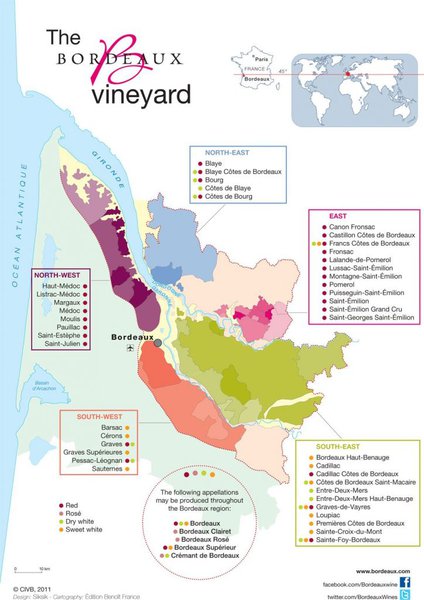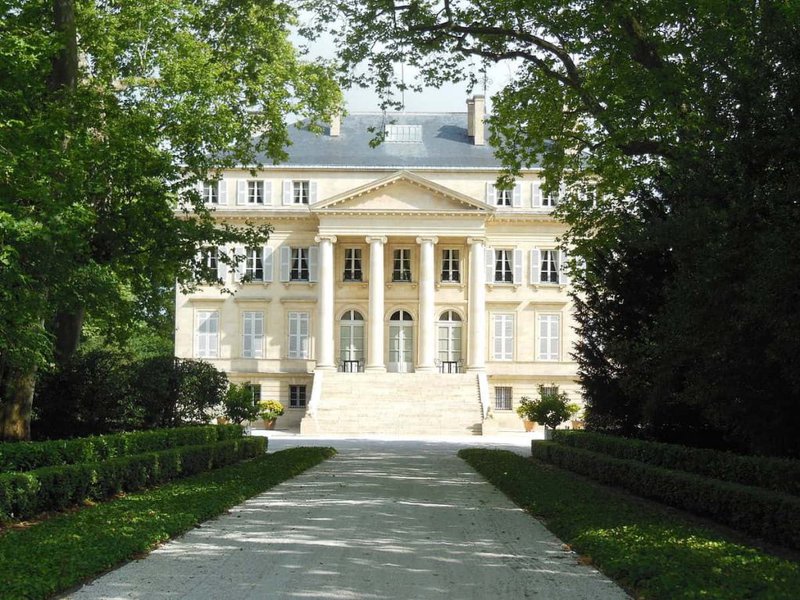Bordeaux is big and diverse. Dividing it up into six families, by place, but more importantly by style, makes it easier to understand rather than trying to understand all the 65 different appellations. 1- Sweet white wines 2- Dry white wines 3- Bordeaux & Bordeaux Supérieur 4- The Côtes de Bordeaux 5- Saint-Émilion-Pomerol-Fronsac (or right bank) 6- Médoc and Graves (or left bank)
White Bordeaux
Bordeaux white wine production is just 11-12%. It is mainly dry with about 2-3% of sweet. Both styles use the same grape varieties, mainly Sémillon, Sauvignon and Muscadelle.
Sweet Bordeaux
The sweetness in wines such as Sauternes comes from residual sugar not fermented into alcohol. This happens when grapes are picked at higher sugar levels, often thanks to the development of a particular type of mould, 'noble rot’ that concentrate the sugars in the grapes before they are picked. Unfairly categorised as 'pudding wines' these wines are amazingly versatile and food friendly. From the classic pairing with foie gras, they can be served from aperitif to dessert, cheese, blue cheese in particular and spicy dishes.
Dry white Bordeaux
The dry white wines from Bordeaux come in two styles:
- Light whites for immediate drinking, often Sauvignon dominated. Characterised by freshness (good acidity), with floral or citrus notes. Look for Bordeaux Blanc appellation or Entre deux Mers for example.
- Barrel fermented whites tend to have more complexity and tannic structure giving ageing potential and are perfect for matching with food. Look for appellations such as Graves white and Pessac Leognan. Try serving them with fish in a light sauce, grilled chicken and dishes with gentle spices like cardamom and ginger.
Red Bordeaux
Bordeaux red blends Bordeaux reds are usually blends of Merlot, Cabernet Sauvignon, Cabernet Franc and Petit Verdot, with some Malbec and Carmenere. The soils define the blend, which explains why place affects style.

source: © CIVB
Bordeaux or Bordeaux supérieur
Despite popular belief most of red Bordeaux wine is eminently affordable. About 60% of Bordeaux wine is appellation Bordeaux or Bordeaux Supérieur (the difference being mainly the lower yield and the longer ageing time before bottling for Bordeaux Supérieur). These wines tend to be easy drinking, Merlot-dominated with red fruits aromas like cherries and enough body to be enjoyed with food but fresh enough to be sipped at the bar.
Cotes de Bordeaux
Cotes de Bordeaux wines fall into a similar style, grown on the slopes (Côtes) that run down to the major rivers of the Garonne, Dordogne and Gironde Estuary this extra drainage and great sun exposure give wines with a little more body, often complemented by barrel ageing.
Left bank : Medoc and Graves
Left bank refers to Medoc and Graves wines an area that represents 18% of Bordeaux production but hits above its size in fame thanks to the top growth such at Margaux, Latour and Lafite that are found here. The warm, stony soils here have great drainage, ideal for Cabernet Sauvignon dominated blends. These give powerful, dark fruit and tannic wines, ideal for ageing, when they gain in complexity. Look for appellations such as Margaux, Saint-Julien, Pauillac, Saint-Estèphe and Pessac Leognan.

Chateau Margaux
Right bank : Saint-Émilion and Pomerol
Right bank refers to Saint-Émilion and Pomerol, here cooler clay and limestone soils dominate, perfect for the more delicate Merlot complimented by Cabernet Franc. These are round, luscious wines with concentrated red fruits laced with vanilla notes from barrel ageing. It represents 11% of Bordeaux production. Dive into the diversity Bordeaux offers; it could be start of a beautiful relationship.
Guest post by Wendy Narby, Bordeaux-based wine educator and wine guide.
Website: Insider Tasting Twitter: @insidertasting


:fill(white):fill_transparent()/sylius_prod/blog/direct-from-vineyard-menu.png)
:fill(white):fill_transparent()/_static/mega-menu/spirits-direct-from.png)
:fill(white):fill_transparent()/_static/mega-menu/offers-best-wine-and-spirits-deals.png)
:fill_transparent()/sylius_prod/blog/bordeaux-wine.png)
No comments
Leave a comment